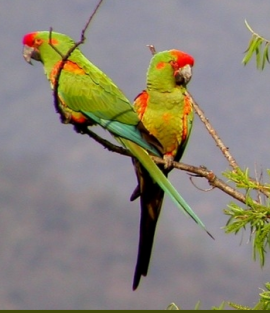Red-fronted Macaw |
|
|
Also known as: Red-cheeked Macaw
Photos
View in GalleryPrograms & Projects
WPT has worked with numerous partners to help save this species. Learn moreAcademic Research
Related publications: Ara rubrogenysSpecies Profile
Genus: Ara | Species: rubrogenys
Size:
60cm (23.4 in)
Weight:
525-550g (18.4-19.25 oz)
Subspecies including nominate:
one
Colour Adult:
Both adults mostly olive/green; orange/red forecrown, ear coverts and shoulder patch; face pink and less bare than other macaws; thighs red; lesser wing coverts, bend of wing, wrist area, and lesser underwing coverts orange/red; tail olive/green tipped with blue. Bill grey/black. Eye orange.
Colour Juvenile:
As in adult but with orange/red on forehead or crown diminished or absent; wing entirely green, thighs green with orange tinge; tail shorter. Eye brown.
Call:
Short musical notes, shrill and ringing, similar to Chestnut-fronted Macaw, given in flight, when feeding or at rest. Call of juvenile less strong and higher pitched. Pairs duet.
Listen NowVideo Links:
Video 1More Information:
Content Sources:
CITES
BirdLife International
Cornell Lab of Ornithology/Birds of the World
A Guide to Parrots of the World, Juniper and Parr, 1998
ML Media Collection Catalogue 132534, Red-fronted Macaw Ara rubrogenys, Hosner, Peter, Cochabamba, Bolivia, Jan. 19 2007, Cornell Lab of Ornithology. Site
Parrots: Status Survey and Conservation Plan 2000-2004, Snyder, McGowan, Gilardi and Grajal, 2000.
Parrots of the World, Forshaw, 2006. 2010 edition
Vanished and Vanishing Parrots, Forshaw, 2017.
Parrots in Aviculture, Low, 1992.
Psittacine Aviculture, Schubot, Clubb and Clubb, 1992.
Photos
View in GalleryPrograms & Projects
WPT has worked with numerous partners to help save this species. Learn moreAcademic Research
Related publications: Ara rubrogenysSpecies Care
Captive Status:
Uncommon in captivity.
Longevity:
Probably up to 40 yrs.
Housing:
Large enclosure if possible, at least 15m (49 ft) long to fly at least for part of the year. Keeping permanently indoors not recommended.
Diet:
Soaked or sprouted sunflower seed, walnuts, roasted peanuts, pecans, Brazil nuts, pine nuts; corn on the cob, bananas, oranges and other fruits; palm fruits if possible. Complete pellet for macaws.
Enrichment:
Enjoy chewing on wood, so provide bird-safe woods (fir, pine, willow,elder) in branches or toys, vegetable tanned leather lacing or toys, puzzle toys. Enjoys bathing, so provide overhead misters for bathing often.
Nest Box Size:
Horizontal macaw box, 16" x 16" x 48" (40.6cm x 40.6cm x 122cm).
Clutch Size:
1 to 3
Incubation Time:
26 days
Fledging Age:
12 weeks
Hatch Weight:
12-16g (0.4-0.5 oz)
Peak Weight:
413-526g (14.4-18.4 oz)
Weaning Weight:
352-477g (12.3-16.7 oz)
Photos
View in GalleryPrograms & Projects
WPT has worked with numerous partners to help save this species. Learn moreAcademic Research
Related publications: Ara rubrogenysSpecies Wild Status
World Population:
About 600
IUCN Red List Status:
Critically Endangered
CITES Listing:
Appendix I
Threat Summary:
A 'restricted-range' species. Approximately 40% of the birds' habitat converted to agricultural use by the 1990s; regeneration of ground cover has been seriously impaired by grazing domestic animals. Some macaws are persecuted as pests for crop raiding. Illegal trapping still occurs.
Range:
Restricted to small area on E Andean slope of C and S Bolivia.
Habitat:
Found in xerophilous thorny scrub with cacti and scattered trees and shrubs. Also steep-sided, undisturbed riverside cliffs for nesting and roosting. Also occur in cultivated areas.
Wild Diet:
Diet includes the legumes Schinopsis quebracho and Prosopis chilensis and Cereus (or Neocardenasia) cactus; also included are Schinus, Aspidosperma, Cnidoscolus, Jatropha, Erythrina, Ziziphus and the grasses Tribulus and Cenchrus; also cultivated crops of maize and groundnuts.
Ecology and Behaviour:
These macaws are noisy and sociable. They are also fairly confiding, leading to human-animal conflict. Are seen in pairs or small flocks.
Clutch and Egg Size:
1 to 3 eggs.
Breeding Season:
October-March; nests are in loose colony in cliff tunnels and occasionally palm tree cavities.
Related Links:
Photos
View in GalleryPrograms & Projects
WPT has worked with numerous partners to help save this species. Learn moreAcademic Research
Related publications: Ara rubrogenysMembers Only Resources
Please log-in now to find more research, resources and tools.
Not a Member?
Find more great information:
Gain exclusive access to 600+ pages of additional research, seminars and podcasts, specialists to ask your toughest questions, and dozens of other fun resources - when you become a WPT member.
Join Today >>

































